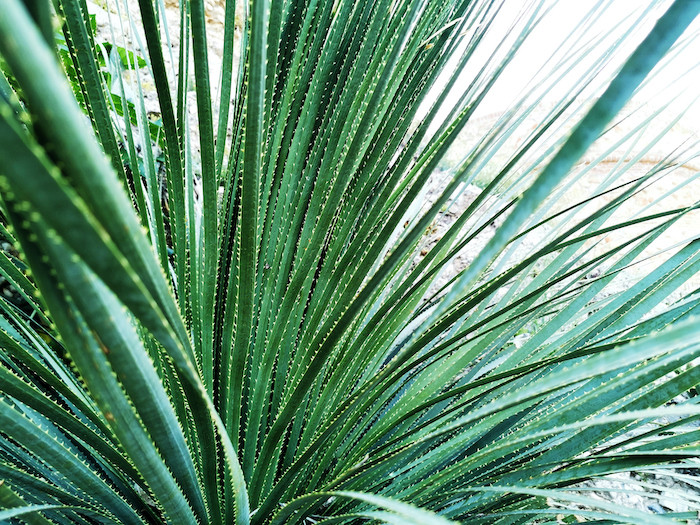
Previously thought of as a mezcal, sotol is a category in its own right. Laura Foster gets into the finer points of a spirit that’s looking to become the next, well, mezcal.
Sotol, while relatively unknown in the UK, has been showing early signs of growth similar to that which mezcal experienced 12 years ago. And with the recent announcement that Lenny Kravitz has partnered with Casa Lumbre spirits to launch new brand Noche Luna, all of a sudden there’s a lot more interest in this relatively enigmatic category. So let’s unravel the mystery.
A Mexican spirit often mentioned in the same breath as tequila, mezcal, raicilla and bacanora, sotol is in fact an outlier of this group. Made from a plant called dasylirion, which is more commonly called desert spoon, or sotol, it mainly grows in the northern state of Chihuahua, takes between six and eight years to mature – similar to blue weber and espadin agave – and has a number of different strains, just as agave does.
In fact, it was once believed that sotol was a type of agave. “We just called it mezcal,” says Gaby Moncada, Speciality Brands’ agave ambassador, who hails from Mexico herself. “The plants look like agave if you’re passing by, but it’s more like a palm tree.
“In the 1990s someone came and studied the sotol plant and realised that it had nothing to do with agave. Some people said it should just continue to be called mezcal.”
This didn’t happen, and sotol is now a spirits category in its own right, with a denomination of origin that covers the neighbouring states of Chihuahua, Coahuila and Durango. Unfortunately, the US doesn’t recognise sotol’s DO, and some sotol producers have popped up north of the US-Mexico border.
Moncada believes there is a historical reason for our lack of awareness. “The main reason we haven’t heard about sotol is because we had Ley Seca, which means ‘dry low’ – a Prohibition in the north of Mexico from 1915 to 1992,” she says. “People were producing a lot of straight whiskey, but it was probably more like a moonshine. They were hidden in the mountains making it and smuggling it to the US.”
Back in Mexico, the temperatures in the Chihuahua desert – where dasylirion is native – can range from -14°C in the winter and 42°C in the summer. “Chihuahua is the size of Germany, so, depending on where you get the sotol plant from, it will be different,” says Eduardo Gomez, sales director of specialist retailer Mexgrocer. It’s unsurprising, therefore, that the terroir from which it comes plays an important part in the flavour of the spirit. “Sotol is incredibly earthy. This category is very complex, and the more you dive into it the more complex it gets,” says Gomez.
Production is similar to that of mezcal. The plant, which grows wild – although attempts are underway to domesticate it in anticipation of an upswing in demand for sotol – is harvested, and the piñas are taken to the distillery or vinata, roasted in ground-level ovens, and milled. Water is added, fermentation takes place and the resulting liquid is double distilled. It is usually sold unaged, but can be aged in American oak barrels to produce reposados and añejos.
The resulting liquid is wild, earthy and evocative of the arid Chihuahua desert.
What’s out there?
There are a few products in the UK for the curious. Gomez’s Mexgrocer offers two in the form of Balam Sotol Sierra and Sotomayor Exceptional.
Under the Balam label, Xavier Villagran releases different spirits from across Mexico, including a couple of sotol. This iteration boasts a dusty nose with green pepper, grass clippings and a touch of sweetness that follows through on the front palate before a whack of drying terracotta, nettles and burnt hay come washing in.
The Sotomayor Exceptional is a blend of dasylirion texanum, leiophyllum and cedrosanum. Aromas of banana leaf, coal embers and anise fill the glass, while the palate is a mix of chewy charcoal, fresh mint, grass cuttings and warming dried chilli spice.
Speciality Brands is representing La Higuera, a brand that makes single-varietal sotol. The two varietals currently on offer here are the Dasylirion Wheeleri and Cedrosanum. The former has strong mineral aromas of chalk and terracotta pots, with green pepper, lifted menthol, lemon rind and sea salt. The palate is initially vanilla-y and sweet, before an intense, dry, rubber character with unripe banana and prickly chilli spice moves in.
The Cedrosanum, meanwhile, has a more restrained nose than the Wheeleri, with used coffee grounds, celery and cucumber and a hint of peppermint. Initial meringue sweetness on the palate is quickly overtaken by a dry barbecue rub-style character, Sellotape and charcoal.
How to use it?
With such a distinctive, unusual and complex flavour, the best way to enjoy sotol is neat, as you would an agave spirit. If you’re wanting to try mixing with it, it’s probably best placed being used as a modifier. For a more balls-to-the-wall experience, give it a go in a Negroni twist.


